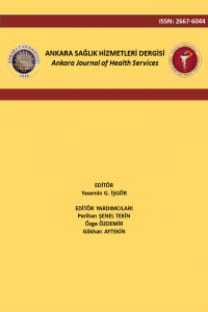The Role of Superoxide Dismutase (SOD) Activity And Malondialdehyde (MDA) Levels in The Differentiation of Benign-Malign Pleural Effusion
Pleural efüzyon, SOD, MDA
The Role Of Superoxide Dismutase(SOD) Activity And Malondialdehyde(MDA) Levels In The Differentiation OfBenign-Malign Pleural Effusion
Pleural effusion, SOD, MDA,
___
- Portakal O, Özkaya Ö, İnal ME et al. Coenzyme Q10 concentrations and antioxidant status in tissues of breast cancer patients. Clinical Biochemistry 2000; 33(4): 279-284.
- Timothy RR, Sharma HM. Free radicals in health and disease. Indian J Clin Pract 1991; 2: 15-27.
- Halliwell B. Reactive oxygen species in living systems: Source, biochemistry and role in human disease. Am J Med 1991; 91: 14-21.
- Halliwell B, Gutterage JMC. Role of free radicals and catalytic metal ions in human disease: an overview. Methods Enzymol 1989; 186: 1-85.
- Galleotti T, Masotti L, Borrello S. Oxy-radical metabolism and control of tumour growth. Xenobiotica 1991; 21: 1041-1451.
- Yamaguchi S, Sakurada S, Nagumo M. Role of intracellular SOD in protecting human leukaemic and cancer cells against superoxide and radiation. Free Radical Biol Med 1994; 17: 389-395.
- Gavino VC, Miller JS, Ikharebha SO et al. Effects of polyunsaturated fatty acids and antioxidants on lipid peroxidation in tissue cultures. J Lipid Res 1981; 22: 763-769.
- Devi GS, Prasad MH, Saraswathi I et al. Free radicals antioxidant enzymes and lipid peroxidation indifferent types of leukemias. Clinica Chimica Acta 2000; 293: 53-62.
- Yoshioka T, Kawada K, Shimoda T, Muri M. Lipid peroxidation in maternal and cord blood and protective mechanisms against activated oxygen toxicity in the blood. Am J Obstet Gynecol 1979; 135: 372-376.
- Yi-Sun, Larry W. Oberley R. Superoxide dismutase. Clin Chem 1988; 3413: 497-500.
- Kakkar R, Mantha SV, Kalra S et al. Time course study of oxidative stress in aorta and heart of diabetic rat. Clinical Science 1996; 91: 441-448.
- Jaruga P, Zastawny TH, Skoleowski S et al. Oxidation DNA base damage and antioxidant enzyme activities in human lung cancer. FEBS Letters 1994; 341:59-64.
- O’Brien PJ. Antioxidants and cancer. Molecular mechanism. In: Armstrong D, Ed. Free radicals in diagnostic medicine. New York; Plenum Press, 1994: 215-239.
- Floyd RA, Soung LM, Walker RN. Lipid hydroperoxide of N-hydroxyl-N-acetylaminofluorane via free radical route. Cancer Res 1976; 36: 2761-2766.
- Cercitti PA. Proxidant states and tumor promotion. Science 1985; 227: 375-381.
- Scott MD, Eaton JW, Frans A. Enhancement of erythrocyte superoxide dismutase activity. Effects on cellular oxidant defense. Blood 1989; 74: 2542-2549.
- Diplock AT, Rice-Evans K, Burdan RH. Is there a significant role for lipid peroxidation in the aqusation of malignancy and for antioxidants. Cancer Prevent 1993; 54: 1952-1956.
- Vanisree AJ, Syamaladevi CS. Status of lipid peroxidation and antioxidant enzymes in malignant (bronchogenic carcinoma) and non-malignant pleural effusions. Indian Journal of Cancer 1999; 36: 127-134.
- Hammouda MA, Khalil MM, Salem A. Lipid peroxidation products in pleural fluid for seperation of transudates and exudates. Clinical Chemistry 1995; 41(9): 1314-1315.
- Dormandy TL. Free-Radical oxidation and antioxidants. Lancet 1978; 1: 647-653.
- Galleotti T, Masotti L, Borrello S. Oxy-radical metabolism and control of tumour growth Xenobiotica 1991; 21: 1041-1051.
- Bhuvarahamurthy V, Balasubramaniant M, Govindasamy S. Effect of radiotherapy and chemoradiatherapy on circulating antioxidant system of human uterine cervical carcinoma. Molecular and Cellular Biochemistry 1996 158; 17-23
- Guyton KZ, Kensler TW. Oxidative mechanism in carcinogenesis. Br Med Bull 1993; 49: 523-544.
- Taniguchi N. Superoxide dismutase significances in aging, diabetes, ischemia and cancer. Rinshe Boyri 1990; 38: 376-381.
- Comporti M. Biology of disease: lipid peroxidation and cellular damage in toxic liver injury. Lab Invest 1985; 53: 599-623.
- Lizuka S. Human manganase-containing superoxide dismutase; immunoassay and contents in lung cancer. Hokkoido Igatu Zasshi 1984; 59: 739-749.
- Durak İ, Canbolat O, Kavutçu M et al. Activities of total, cytoplasmic and mitochondrial superoxide dismutase enzymes in sera and pleural fluids from patients with lung cancer. Journal of Clinical Laboratory Analysis 1996; 10:17-20.
- Yayın Aralığı: Yılda 2 Sayı
- Başlangıç: 2000
- Yayıncı: Ankara Üniversitesi
Postoperatif Ağrıda Transdermal Fentanil Kullanımı
Epidermoid Baş-Boyun Kanserlerinin Tedavisinde Hiperfraksiyone Radyoterapi Sonuçları
Ayşe HİÇSÖNMEZ, Yıldız GÜNEY, Ayşen DİZMAN, Nalça ANDRIEU MELTEM
S İNAN, T ÖZGÜDER, H.S. VATANSEVER, K ÖZBİLGİN, M. SANCI, S. SAYHAN
Ulukavak ÇİFTÇİ TANSU, Yıldız GÜNEY, Ayşe BİLGEHAN, Filiz ÇİMEN
Yıldız GÜNEY, Ayşe BİLGİHAN, Ulukavak ÇİFTÇİ TANSU, Filiz ÇİMEN, Özgür COŞKUN
Normal ve Sezeyan Doğumlarda Maternal ve Umbinikal Kordon Karnında Endotelin-1 Düzeyleri
BÜLBÜL BAYTUR Yeşim, Cevval ULMAN, Göker TAMA Aslı, Ahmet VAR, Hüsnü ÇAĞLAR
Endometriyal Hiperplazilerin Tedavisinde Vajinal Progestoron Jelin Etkinliği
Bülbül BAYTUR YEŞİM, Semra ORUÇ, Barış ÇOBAN, Fatma ESKİCİOĞLU, Rıza KANDİLOĞLU Ali
